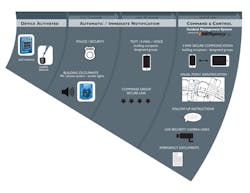Command and control capabilities added to BluePoint's RERS solution
BluePoint Alert Solutions, provider of the Rapid Emergency Response System (RERS), recently announced that it has added command and control communications capabilities to its system. The RERS solution leverages strategically placed pull stations and wearable pendants that are integrated with a facility’s public address and/or phone system along with interior and exterior strobes to immediately notify police and building occupants of an emergency situation.
“The key to our system is the first eyes that see trouble are able to alert everyone in the building and police immediately,” said John Shales, co-founder of BluePoint.
Founded in 2013, BluePoint developed the industry’s first police rapid emergency alert pull station. According to Shales, the company is tightly focused on not only providing rapid notification of emergencies, but also on providing first responders with the best information possible to make the right decisions which is really where these new command and control capabilities come into play.
The BluePoint Command & Control Incident Management System, powered by Emergency 24, is a web-based communication portal designed to help end users better manage a variety of life-threatening events, such as armed intruders, natural disasters, hazardous materials release, etc. While the company has up until now been focused on alerting people and making sure they are aware that an incident is occurring within their vicinity, this new functionality can provide people with more precise information about an incident and where it may be occurring, which can help them make a more well-informed decision.
When activated, text, email and voice notifications are sent to pre-determined stakeholders and a command group is established. The command group can securely and quickly access the communications portal via any internet-enabled device – mobile phone, tablet or personal computer. Once connected, the command group has secure, two-way communication that is required to coordinate first responders, communicate with occupants and manage the overall situation quickly and efficiently.
“As a situation unfolds, one of the things that a command group or a leadership group needs to do is make good decisions. That’s the focus of our command and control incident management system,” explained Shales
For example, if a teacher gets a text or an email from the command group that an incident is unfolding in the school’s gymnasium, they may have a better idea, given where they are located in the building, of whether or not to follow lockdown procedures or attempt an evacuation with their students.
“Now, we’re equipping them with more information and also with that text or email they can reply to it,” added Shales. “This is using a device that they are used to using, their phone or iPad, in a way that they are used to using it – text or email – and now they are able to apply that in a secure fashion. At the start of the communication, they are sent a link and a reply that is unique for every incident, so before an incident they have no idea what that link would be but since we’re establishing it, now they can reply to it.”
The location where an incident is occurring can also be easily pinpointed, according to Shales, because all of the company’s devices are point identifiable. The system can also link the command group with live security camera video if available, as well as visual point identification (VPI) diagrams of the facility and emergency preparedness documents to ensure all vital information is available quickly and easily.
Shales said that they can also enable a two-stage response for end users that want to have emergencies verified prior to having police dispatched.
“We can either have two devices activate before we roll police, so if the first device is activated, we’re going to contact the building leadership group – maybe it’s 10 people onsite – they get a text or an email saying that the device in the gymnasium was activated and we don’t set off strobes or the PA system on one activation because (security personnel) are responding to it. The second stage is if another device is activated, we go into pull protocol,” said Shales. “We do have that capability. Most schools are not opting for that, but on the private side we are seeing more interest in two-stage response.”
Shales said that the command and control system will be a standard feature on its RERS solution moving forward.
About the Author
Joel Griffin
Editor-in-Chief, SecurityInfoWatch.com
Joel Griffin is the Editor-in-Chief of SecurityInfoWatch.com, a business-to-business news website published by Endeavor Business Media that covers all aspects of the physical security industry. Joel has covered the security industry since May 2008 when he first joined the site as assistant editor. Prior to SecurityInfoWatch, Joel worked as a staff reporter for two years at the Newton Citizen, a daily newspaper located in the suburban Atlanta city of Covington, Ga.

